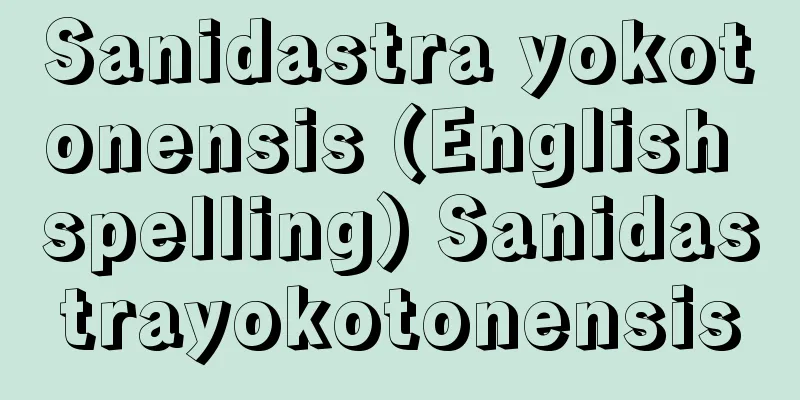Kamioka mine

|
This non-ferrous metal mine was located in the Kamioka area of Hida City, Gifu Prefecture. It was known for producing zinc, lead, silver, etc., but closed in 2001. Its main deposits were the Tochibora, Maruyama, and Mozumi deposits scattered in the mountains along the right bank of the Takahara River, and the Tochibora deposits in particular were located near Funatsu, the central area of Kamioka Town, and contained over 10 deposits of various sizes. The development of the mines began during the Tensho period (1573-1592) by Mozumi Munesada, who served the Kanamori clan, lord of Takayama Castle. The Wasaho mines in particular flourished as a silver mine during the Keicho period (1596-1615). In 1692 (Genroku 5), Hida became a Shogunate territory, and the mines came under its control. After being purchased by the Mitsui Group in 1874 (Meiji 7), modern, large-scale development was gradually promoted, and refining methods also improved. The development of the Kamioka mines was particularly groundbreaking during the country's period of high economic growth after World War II. As one of Japan's leading non-ferrous metal mines, it mainly produced zinc and lead, but also silver, gold, bismuth, cadmium, and sulfuric acid. However, due to sluggish sales of zinc and lead from the late 1970s, a second rationalization plan was implemented in 1978 (Showa 53) and many employees were laid off. In 1986, management was transferred to Kamioka Mining, which had been spun off from Mitsui Mining & Smelting, and the mine closed in 2001 (Heisei 13) due to the depletion of ore reserves and other reasons. In 1968, a pollution lawsuit was filed against the company for "Itai-itai disease." The Kamioka Observatory (Institute for Cosmic Ray Research, University of Tokyo) is located here, and observations are carried out using the Super-Kamiokande neutrino observation device, which was built 1,000 meters underground in the Mosumi Mine. [Masanobu Ueshima] [References] | | | |Source: Shogakukan Encyclopedia Nipponica About Encyclopedia Nipponica Information | Legend |
|
岐阜県飛騨市(ひだし)神岡町地区にあった非鉄金属鉱山。亜鉛・鉛・銀などの鉱山としてしられたが、2001年(平成13)閉山した。かつて、その主力をなしていた鉱床は、高原(たかはら)川の右岸に沿う山地に散在する栃洞(とちぼら)、円山(まるやま)、茂住(もずみ)の鉱床群で、なかでも栃洞鉱床群は神岡町の中心地区船津に近く、大小10余の鉱床がみられた。 鉱山の開発は、天正(てんしょう)年間(1573~1592)に、高山城主金森氏に仕えた茂住宗貞(むねさだ)によって始められたという。とくに和佐保鉱山(わさほこうざん)は慶長(けいちょう)年間(1596~1615)には銀山として盛況であった。1692年(元禄5)飛騨は幕府領となり、鉱山もその支配下に置かれた。1874年(明治7)三井組に買い取られてから、しだいに近代的で大規模な開発が推進され、精錬方法も進歩してきた。とくに第二次世界大戦後、国の高度成長期において、神岡鉱山の発展も画期的であった。日本を代表する非鉄金属鉱山としておもに亜鉛と鉛を産し、ほかに銀、金、蒼鉛(そうえん)、カドミウム、硫酸なども産出してきた。しかし、1970年代後半から亜鉛、鉛の売れ行き不振などで、1978年(昭和53)には第二次合理化計画が実施され、多数の従業員が整理された。1986年からは経営が三井金属鉱業より分離独立した神岡鉱業に移り、2001年(平成13)鉱量の枯渇などの理由で閉山した。1968年には「イタイイタイ病」公害訴訟が起こされている。 神岡宇宙素粒子研究施設(東京大学宇宙線研究所)があり、茂住坑の地底1000メートルに建設されたニュートリノ(中性微子)観測装置スーパーカミオカンデにより観測を行っている。 [上島正徳] [参照項目] | | | |出典 小学館 日本大百科全書(ニッポニカ)日本大百科全書(ニッポニカ)について 情報 | 凡例 |
Recommend
Isoquinoline alkaloids
A general term for a group of alkaloids that are ...
Inheritance of the title - Idaikeisho
This is one of the question-and-answer formats in...
Exner, F.
…This theory was later refuted by the research of...
Kimamazukin - Free-spirited hood
〘 noun 〙 A hood made of black silk that covers the...
Albany Congress - Albany Congress
The North American Colonial Congress was held in A...
Bharatpur (English spelling)
…Unlike the Rajputs, they did not form a kingdom ...
Dinocrates
…date of birth and death unknown. Latin name Dino...
Glass fiber
…Since then, research and development into optica...
Branching enzyme
An enzyme involved in the formation of carbohydrat...
Otone Irrigation Canal
This is agricultural water for the northeastern p...
Kanto Loam - Kanto Loam
A brown soil (loam) originating from Quaternary vo...
Watari [town] - Watari
A town in Watari County, in the southern part of M...
Fremantle
…It has an international airport and is connected...
Krill - Okiami (English spelling) krill
A general term for the order Euphausiacea of th...
Year Star - Saisei
The Chinese name for Jupiter. One of the five star...


![Long-Term Credit Bank of Japan [Stock] - NIHON CHOKISHINYOGINKO](/upload/images/67cc711db17ee.webp)






